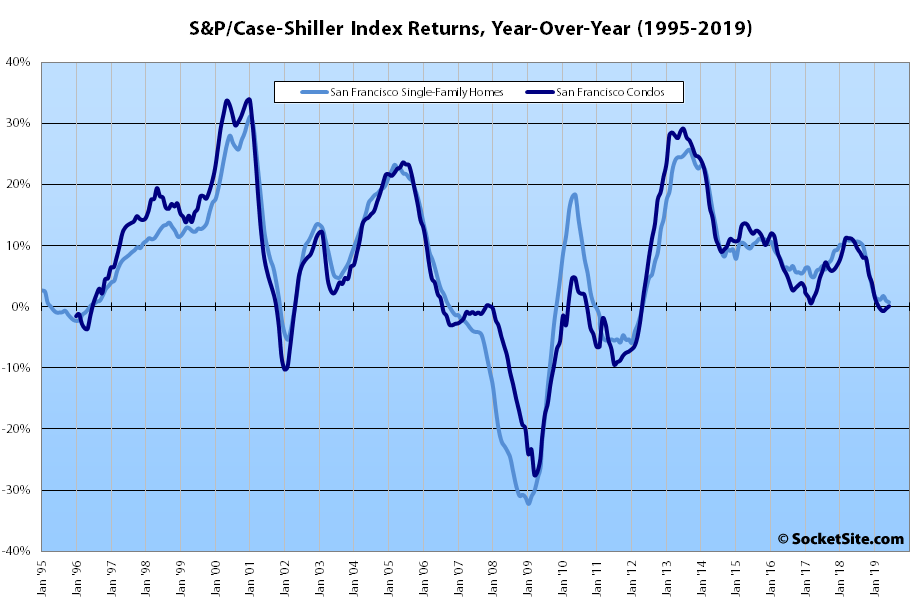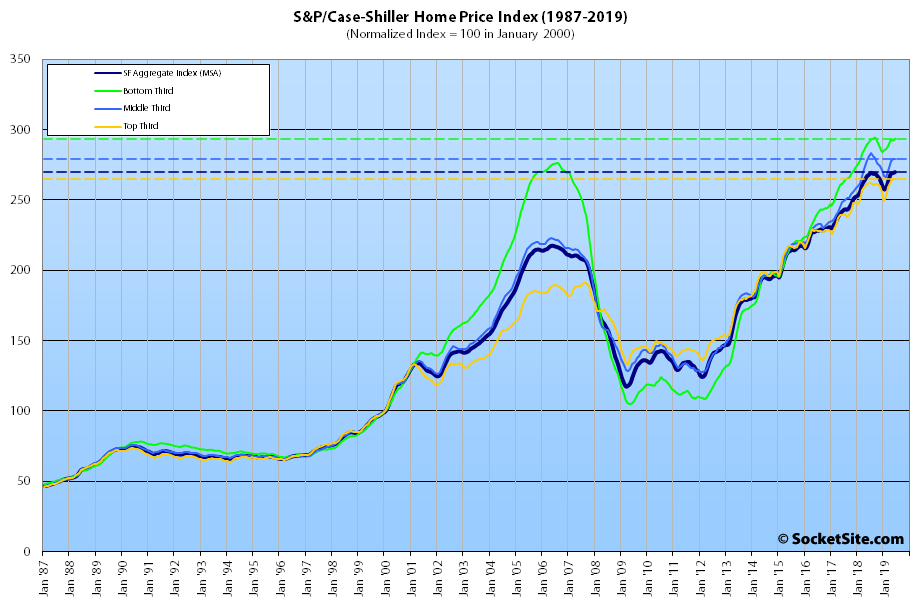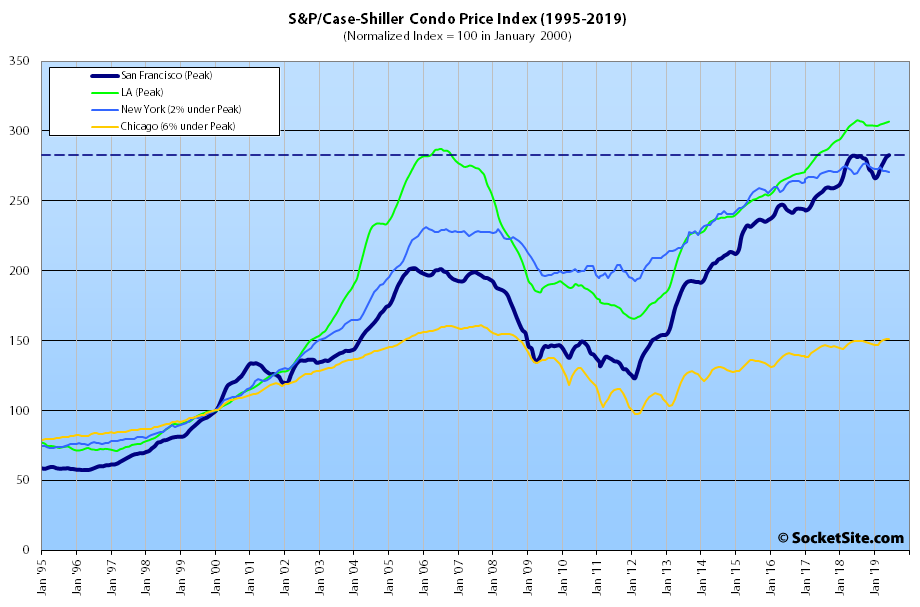Having inched up 0.3 percent in May, the S&P CoreLogic Case-Shiller Index for single-family home values within the San Francisco Metropolitan Area – which includes the East Bay, North Bay and Peninsula – eked out a 0.2 percent gain in June.
As such, the index is now 0.2 percent above its peak in the third quarter of 2018, at which point it was up 10.7 percent on a year-over-year basis.
But the year-over-year return for the index has dropped to 0.7 percent, which is the smallest year-over-year gain since the second quarter of 2012 and down from a 10.6 percent year-over-year return at the same time last year, and that’s with a dramatic drop in mortgage rates.
At a more granular level, the index for the bottom third of the market inched up 0.4 percent in June for a year-over-year gain of 0.9 percent (versus a year-over-year gain of 11.1 percent at the same time last year); the index for the middle third of the market inched up 0.2 percent but dropped 0.5 percent on a year-over-year basis, which was the first year-over-year drop for the middle tier since the second quarter of 2012; and the index for the top third of the market eked out a 0.1 percent gain for a year-over-year gain of 1.3 percent (versus a year-over-year gain of 9.3 percent gain at the same time last year).
Having inched up 0.6 percent in June, the index for Bay Area condo values managed to eke out a year-over-year gain of 0.1 percent.
Phoenix is now leading the nation in terms of home price gains, up 5.8 percent on a year-over-year basis, followed by Las Vegas (up 5.5 percent) and Tampa (up 4.7 percent).
And at 0.7 percent, San Francisco ranked next to last in terms of year-over-year gains for the top 20 metropolitan areas in nation, above only Seattle (which was down 1.3 percent) and versus a national average of 3.1 percent.
Our standard SocketSite S&P/Case-Shiller footnote: The S&P/Case-Shiller home price indices include San Francisco, San Mateo, Marin, Contra Costa and Alameda in the “San Francisco” index (i.e., greater MSA) and are imperfect in factoring out changes in property values due to improvements versus appreciation (although they try their best).



So, new record high prices for bay area homes. But prices aren’t rising as quickly as they were a few years ago. “The downturn is upon us” is still an incorrect call. Some day…
And as this San Francisco housing blog points out, home prices are rising faster in Phoenix and Las Vegas. Uh, okay.
To Fogheads everywhere:
Ten Great Songs from One Great Year!
Today, it’s the year of Total Recall, the reunification of Germany, and Twin Peaks. Let’s do the time warp again!
It’s … 1990!
We’ve got a bit more tailwinds than June of 1990, so lets see if we can stay positive in July to avoid a repeat of the past.
10 year treasuries below 1.50. For all of the positive factors and hype, .7% YoY seems pretty weak. I’m not a housing bear, but for people who haven’t bought yet, think there is no rush from a risk/reward standpoint. Yes, I know- the uber ipo lockup period ending is the next hyped event that will eat up x times the current inventory…
.1% gain is still good right? Except, interest rates are down a full point which shaves 9% off of the monthly mortgage payment, which means buyers are willing and able to pay about 91% of what they were a year ago. But wait, there’s more. CPI ex-shelter is up 2.3%, so when we adjust for inflation that number is even lower. But I’m not done yet. Median hourly earnings are up 3.2% during this same period.
Seattle is growing 4 times faster than SF and has been the second (to Atlanta) fastest growing large metro this decade. Yet home prices there fell YOY – to date. The reason? Seattle/King in building a massive amount of new housing – much more than the larger SF metro. Seattle’s government and business leaders have wanted to avoid the Bay Area’s housing crisis – as in not becoming so unaffordable that much of the middle class is forced to move away or live hours away (from work).
It looks like Seattle is going to successfully do what the BA did not do – did not even try to do – as in remain affordable and from that become even more of a magnet for jobs. Meanwhile, San Francisco and San Jose remain the most unaffordable housing markets in the country. Even with significantly slowing appreciation. Unfortunately, for the Bay Area, the horses have long since escaped the barn and bringing them back – making the Bay Area much more affordable – is probably not going to happen.
Seattle is suffering huge growing pains problems, Dave. The fact that you turn a blind eye to its increasing affordability crisis, mono-culture fears and backlashes, as well as its increasing traffic snarl problems says everything about you.
My point was housing affordability. Seattle is significantly more affordable than SF – even though affordability is not as good as it should be in Seattle. So, prices down 1.3% in Seattle with wage base up and in SF prices up .7%. Seattle is becoming more affordable despite massive growth, the Bay Area remains unaffordable despite sluggish growth.
and they are investing more in transit infrastrcuture. seattle is a model SF should follow
Yes, Seattle/King is rolling out new light rail lines every 3/4 years for the next decade.
My pal who lives in Ballard told me that the proposed north side extensions are like 15 – 20 years away and may not even happen. As it stands the north side of Seattle is really pretty terrible as far as transit is concerned.
Your points are directionally correct. However, it’s not quite a fair comparison. If San Francisco had 84 square miles of land (vs 49) and a population density of 8K/people per mile (vs 18K), San Francisco would have built more. It’s easier for Seattle to build than us. Plenty of blame falls on our processes as well, of course.
Actually Seattle/King issued almost 26K permits for new housing in 2017 alone. That is much more than was issued in the SF/Oak metro area. And Seattle/King is slightly less than half the population of the SF/Oak/Hayward metro. The difference in per capita new residential permits issued between the two metros is staggering and tells the tale. The BA still is not addressing this. The Central SOMA Plan has an outrageous 6/1 office worker/housing ratio and Brisbane’s Baylands, with 9 million square feet of new office space, will have virtually no new housing built to accommodate the tens of thousands of new workers.
SF’s footprint is absolutely not the limiting factor to density. See Manhattan.
It’s politics and nimby’ism that keep SF from being a normal city.
What’s normative there? A European city model with mature, extensive transit? Feel free to examine where San Francisco exists on that spectrum in terms of American cities. That said it could be better, certainly. And had Marin County opted into BART it would have been already. That singular oversight has plagued the Bay Area more than anything else. Is it a fait accompli? Well, I’ll tell you what. If Seattle can get rail to Ballard then SF can damn sure get rail out to the Richmond District.
New York is expensive precisely because it is dense.
If the objective is to increase property values and rents (iow, the occupational objective of all bankers, landlords, developers, and realtors), increasing density is the fastest and surest way to that goal.
It looks to me like the best way to increase property values is to limit development. That’s what San Francisco and Palo Alto have done and look what it has done to our property values.
It’s more nuanced than that. NYC densified for two hundred years before the environmentalism and anti-development movements became a thing in the 1970’s. San Francisco (and the West Coast a whole) didn’t have that time luxury to densify.
If you’re holding out Manhattan as a “normal” city to compare S.F., well then, yes, you’ll be frustrated with San Francisco. Most San Franciscans don’t want San Francisco to be turned into Manhattan with almost the same level of commitment that people in the real estate “game” (like landlords, developers and real estate agents) want the opposite. The folks in the latter group are of course arguing in favor of their pecuniary interests.
Over 50% of commuters in New York City use public transit. Do you know what the corresponding number in San Francisco (home of Uber) is?
The Case Shiller home price index for Seattle hovers around 255 and the index for San Francisco is around 268. It’s not clear that Seattle is remarkably better in absorbing growth while maintaining affordability.
In terms of salaries needed to afford a home, San Jose is at 250K, SF is at 200K and Seattle is 100K. Big difference. Take a non-tech job in service. A Pete’s store manager can make around 60K in SF and about the same in Seattle. There are a lot of non-tech jobs where one can pull down 100K in SF and Seattle – but only in Seattle does one have the ability to purchase a home.
The Case Schiller numbers mentioned by Jake does not seem to support your claim, Dave. Is the Peet’s manager really able to buy a house in the City of Seattle or Central Puget Sound area? Or, is he or she commuting from the Seattle equivalent of Manteca? I am skeptical a “home” can be purchased in Central Seattle for a $60K salary.
Check median home prices and median income in San Francisco and Seattle. The median incomes are almost the same – Seattle is actually several thousand more than SF. The median San Francisco home price is 1.3 million, the median in Seattle is 714K. A Peet’s manager in Seattle who took a second job might be able to get lucky and purchase a condo. No way in SF.
That says more about the relative wages of Seattle and SF 20 years ago than the relative management of growth in the years since. These values are normalized to prices in 2000 for each city.
I don’t think anyone can dispute that Seattle is building way more homes than San Francisco. It’s great news for San Francisco homeowners!